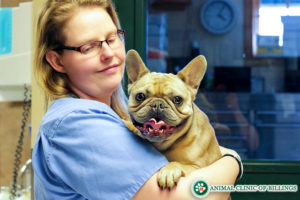Lateral Humeral Condylar Fracture in Dogs
What are humeral condylar fractures?
Lateral Humeral Condylar Fracture in dogs are common (they can also occur in cats) with approximately half of all humeral fractures occurring in the distal (lower) portion of the bone, at or near the elbow joint. The vast majority of distal humeral fractures involve the elbow joint and are classified according to their anatomic location. The end of the humerus that forms the upper part of the elbow joint is composed of two halves, called the medial and lateral condyles, which are separated down the middle in young dogs by a growth plate that normally fuses upon reaching adulthood. Distal humeral condylar fractures are much more common in dogs than they are in cats.
Lateral condylar fractures occur when forces concentrated on the lateral portion of the elbow joint cause breakage along this vertical growth plate and through the lateral portion of the bone above it. This type of fracture is most common in young dogs and may occur with minimal trauma as a result of the relative weakness of the growth plate. It is also not uncommon to see this type of fracture in mature dogs, with spaniel breeds being at increased risk due to a genetic predisposition to incomplete growth plate closure in this location. While lateral condylar fractures are most common, sometimes the medial condyle or both condyles may be fractured (called a “Y” or “T” fracture).
How are humeral condylar fractures diagnosed?
Fractures of the humeral condyles are diagnosed by taking x-rays of the elbows. Because of the discomfort caused by this injury and the need for very precise positioning, sedation and pain medication are necessary to take diagnostic x-rays. Occasionally, more advanced forms of diagnostic imaging of both elbow joints, such as a CT scan, can provide additional information that will be necessary for treatment.
How are humeral condylar fractures treated?
Surgery is the best treatment for humeral condylar fractures. Because these fractures run through the joint surface, perfect alignment of the fractured fragment with inter-fragmentary compression is necessary in order to restore elbow function. The operation involves precisely realigning the bone fragments and stabilizing them using bone plates, screws, and pins.
Fracture repair can be challenging due to the involvement of the joint (and the consequent need to meticulously reconstruct the fracture to minimize the future development of osteoarthritis), the small size of the fragments, and the underlying weakness of the growth plate that can affect the healing process after a fracture. However, with appropriate surgical techniques from a veterinarian with extensive humeral condylar fracture repair and sugery experience, most dogs are very comfortable after surgery and can start to bear weight on the limb in as little as one or two days.
What aftercare is needed?
Most dogs can go home as soon as the day after surgery with only a light bandage on the limb. When a dog goes home after surgery, one of our physical rehabilitation technicians will demonstrate the passive and active exercises that should be performed at home with the patient. Short walks on a short leash can be started immediately, but all unrestricted or unsupervised exercise, such as running or jumping needs to be avoided. As with most fractures, pain medications are usually given for a week or two. Dogs that have undergone surgery will need to be taken to their vet for a check-up one week and then two weeks after surgery to have their stitches removed.
Regular physical rehabilitation therapy appointments are a very beneficial addition to the at-home exercises in patients healing after surgical repair of an elbow fracture. At these appointments, modalities such as laser therapy and underwater treadmill are used to facilitate healing, and improve joint function and limb use.
We typically plan to reevaluate dogs about six weeks after surgery with a physical exam and x-rays to assess limb function and bone healing. At this point, if healing is progressing well, a gradual increase in physical activity may be initiated. Typically if all goes well, a dog can be expected to return to full physical activity by 4-6 months post-injury.
What are the risks and possible complications of humeral condylar fractures in dogs?
Although surgery is highly successful in the majority of patients, there are potential risks and complications. These may include implant breakage, infection, and poor bone healing. Long term, some degree of osteoarthritis is practically inevitable, but in many cases, this doesn’t cause any major problems.
All aspects of your dog or cat’s care, including the risk of any underlying complications will be carefully explained by your veterinarian in detail during your initial consultation with your veterinarian before any treatment is started.
What is the prognosis for humeral condyles fracture surgery in dogs?
The prognosis following surgery for fractures of the outside (lateral aspect) of the humeral condyle is generally good, although because of joint surface involvement, some degree of osteoarthritis will eventually develop in the elbow joint.

Let our highly trained and experienced team of veterinarians and veterinary technicians help you keep your dog as happy and healthy as they can be.
Call the Animal Clinic of Billings and Animal Surgery Clinic to schedule your pet dog’s next wellness examination with one of our veterinarians today!



